| |
“So Carol (Reed) suggested to me I’d notify Alexander Korda that I wouldn’t sign a new contract as an assistant director, unless he promised me a picture to direct. Three or four days later, a telegram arrived which was handed to Carol. It said, ‘Dear Carol, you put him up to it, you bastard! Love, Alex…’” |
| |
Director Guy Hamilton at the start of his career working
as an assistant director for Carol Reed on The Third Man* |
There are world events than simply cannot be ignored even in the context of our humble film-championing site. And for once I’m not talking about the Covid19 pandemic. Force 10 From Navarone, like any film of a certain vintage, is buffeted and shaped by its own era’s societal eddies and currents. It’s also a film made in 1977 about events 34 years earlier (albeit fictitious events). So as a filmmaker, you make a choice. “Do I make this film trying to stay true to the unfettered racism of the time it was set or do I sneak a more modern sensibility in to file down those rough edges?” It seems that Hamilton and screenwriter Robin Chapman and an uncredited George McDonald Fraser went for ‘realism’. The upshot of this is that almost every scene with Carl Weathers, Stallone’s African American opponent from Rocky released a year earlier, is excruciating to watch. I just wanted to mention this up front not as a warning per se but a gentle heads up. If you ever go back and re-read Agatha Christie or Conan-Doyle, you’d be surprised at how often their characters ejaculate. Not to be indelicate but there are ejaculations all over the place… It’s an example of how one meaning has dominated its broader definition of saying something quickly and suddenly. The racism should not stand in the way of what is a very solid war thriller directed by one of the best in the business but while the racist language doesn’t affect the whole experience, it does pop up every now again to remind us how corrosive racism is and how casually ‘normal’ it once seemed to be. I did enjoy the inter-racial kiss even if it was between Weathers and Edward Fox… “Steady on, steady on!” The death of George Floyd at the hands of a policeman named, of all things, Chauvin, has lit the world up in a blazing indignation. It would be remiss not to take these events and cultural concerns into consideration. I have justifiable concerns for those earnest protesters who might put themselves at risk or even die by surrounding themselves with possible Corona infected comrades-in-arms. Today is the worst time to protest shoulder to shoulder especially if genetically you are more susceptible than most to this pernicious virus. On to less frightening subjects… World War II…
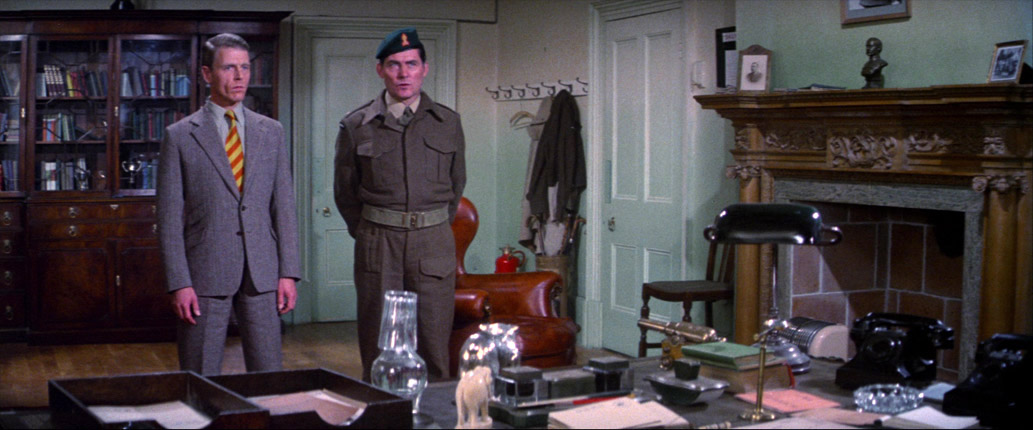
Characters Captain Mallory and Corporal Miller, played by Gregory Peck and David Niven respectively, are the survivors of the attack in The Guns of Navarone. They are replaced in the recap of the first film by Robert Shaw and Edward Fox. They have subsequently been recruited to find and assassinate a spy in the Yugoslavian partisan fighters, a Captain Lescovar played by Franco Nero. Escorting them to their destination is Lt. Col. Barnsby played by Harrison Ford, leading a crack sabotage group known as Force 10. During this period between A New Hope and The Empire Strikes Back, Ford took on a number of diverse roles to try and not be typecast as dashing rogue Han Solo. His physical presence and good looks didn’t allow him too much leeway (his interpretation of Quasimodo was a no starter) but it’s clear from this performance that the young actor was still finding his feet. After all, it was during this film’s production that he learned (as a one time humble carpenter) that he would never have to work for money ever again. Such was the economic powerhouse known as Star Wars that summer. He’s easier to watch as the scoundrel cowboy (heard that somewhere before) in The Frisco Kid and mild-mannered as the Lennon-glasses wearing clerk in Apocalypse Now. His Hanover Street pilot was pretty typically Ford but at least he got a stab at romance (and disappeared down Flamingo Lane, Bruce fans). There are several Ford trademarks - the pointing and straining under duress - but think of these early roles as necessary training for a certain Professor Jones, a role I think Ford comfortably grew into.
Robert Shaw as Mallory incorporated the actor’s own limp into his character and apart from sporting a very fetching leather jerkin, his character does very little except go around with everyone else rarely making decisions that propel the action forward though his dry humour serves the film well. As soon as they’ve reached their target, all is defused and out of the blue a bridge is targeted as we’ve long since forgotten about that fictitious island in the Aegean that is such an intrinsic part of the film’s marketing. Navarone Island, author Alistair McLean’s imaginary location, might as well not exist (it doesn’t, I checked – Ed.) for the importance it plays in this sequel. In fact Force 10 is not from Navarone at all but a little village in Dorset. Try selling Force 10 from Briantspuddle. Edward Fox has far more fun clutching his suitcase of explosives and being the unassuming, wily Englishman with a bomb for every occasion. Despite the appalling racism, Carl Weathers is a breath of fresh air, under arrest and joining the team because it was just a convenient way to escape his captors. He serves as the role of the guy who knows nothing whose ignorance keeps the audience clued in as to what’s going on. He’s also a great source of energy in the film with his reaction to Fox’s handiwork particularly entertaining. There is a delightful reunion of two actors whose work in the Bond film The Spy Who Loved Me was such a treat a year earlier. We have Richard Kiel, the seven foot two inch giant as Captain Drazak collaborating with the Nazis (spoiler, damn) and Barbara Bach, the sultry beauty whose charms as local girl Maritza keep the Nazi commander Major Schroeder in check. The pairings don’t stop there. Schroeder is played by Michael Byrne, a British actor who was so much more familiar to me in his signature film role as (another Nazi) Vogel in Indiana Jones and the Last Crusade. I kept on expecting him to scream “Wo ist Jones!” I’d like to think Harrison Ford might have suggested him for the role. In a smaller part Wolf Kahler crops up as a Nazi soldier. Kahler was one of the Nazis who melted being exposed to the spectral contents of the Ark of the Covenant in Ford’s first outing as Indiana Jones. The rest of the cast is uniformly excellent if a little too casual once all lined up to be shot. “At least we got a good night’s sleep!” says Shaw. Indeed.
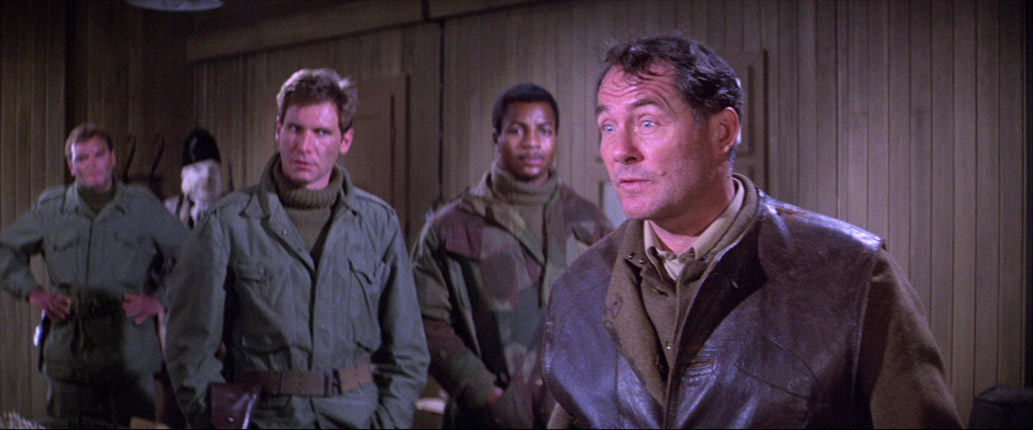
Force 10, if you ever needed to look up the word ‘yarn’ in a dictionary, would be your cinematic definition. Guy Hamilton keeps the pace spry and there’s never a dull moment if a Boy’s Own adventure is what you’re in to. Ron Goodwin’s strident score is very solid and somewhat familiar if you’ve seen his other scored war pictures. Raymond Poulton’s editing is always invisible (that is a good thing) and with the exception of water, a substance impossible to miniaturise, the special effects are certainly pretty good if not utterly convincing (water being the main let down). To make water appear totally convincing, your ‘miniature models’ would have to be life-sized which kind of defeats the idea of building miniatures. Special effects supervisors, in whose hands the climax succeeds or fails, hardly ever get any kind of recognition so the three main supervisors were René Albouze, Giuseppe Carozza and Peter Hutchinson... Hats off to their efforts. Oh, and as a silly aside, how many films do you know that spoil their explosive climax on the damn poster?
Disc 1 - Extended version with original mono audio, and alternative stereo and 5.1 surround options (126’)
Considering from the extra features, the movie was shot under dreary grey skies and at night, it’s scrubbed up pretty well. There’s some grain (almost inevitable in night scenes) and in some of the model effects shots (spoiler?) there is a faint light flicker, something that is only ever irritating if you actually notice it. I can only think that a pin prick of light must have got in to the film magazine but the team decided the shots were too important not to use and too expensive to re-do. When the sun was shining, so do the shots but there are very few traces of physical damage. With no actual ill will towards the model shoot but the wide angle does sport a mustard coloured blob, which is oddly in the same shape of the fictitious island of Navarone.
I would always opt for the 5.1 mix every time for what must be obvious reasons by now but the sub is barely used despite the plethora of explosions and rumble potential. Two things to mention; as doctor visits are mostly banned in a lockdown, I couldn’t get my right ear sorted and so am partially deaf on that side. But I have seen the 5.1 version three times now and my sub didn’t so much as twitch. The second thing is that I do not know how much effort or money goes into remixes of newly restored Blu-rays or whether there is a software option that just ports the mono into a stereo and a 5.1 version. I suspect great care is taken but unless you hire a sound editor to completely re-lay the film, re-fashion the sound effects etc., the sub-woofer is going to stay unutilised.
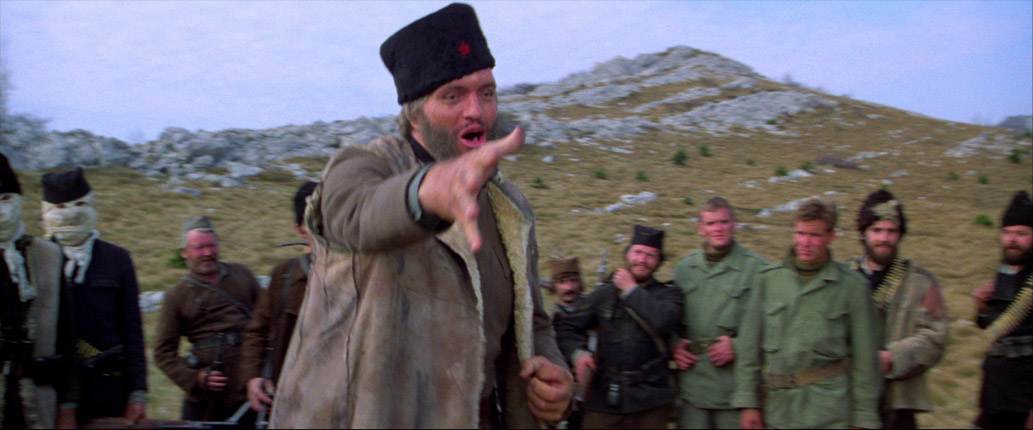
Disc 2 - Limited edition exclusive presentation of the original theatrical cut, with mono audio (118’)
As the same mustard mark on the film appears in both versions in the same shot, I’m assuming certain sections of the film shared a master negative but the re-edits are such that there must have been a master negative copy for both versions. Please see the extra, entitled A Show of Force to understand the complexities of the different versions.
For both versions, there are new and improved English subtitles for the deaf and hard-of-hearing.
Audio commentary on the extended version with film historians Steve Mitchell and Steven Jay Rubin (2020)
Enthusiastic and passionate, the two Steves know their stuff and they carry the commentary on a torrent of overflowing detail. Each name-checked actor gets a comprehensive life story and if there is any repetition it’s only because they make a lot of points that I too was prompted to write about. The masculine appreciation of Barbara Bach may skirt around the fringes of a potential twitter storm (as I write, a world famous author is being hounded for stating facts, deep sigh) but it’s just another branch on the tree of enthusiasm. They also appear to be military equipment experts, a fact which lends them more credibility with this sort of film. It bothered me a little that a 2020 commentary didn’t touch on the racism in the film (not that when they recorded it they could have foreseen today’s alarming events in advance). In fact, no extra takes this aspect on at all which I find again, a little strange.
This Is a Giant Movie (1978): archival location report by Channel Television featuring interviews with producer Oliver A Unger, and actors Edward Fox and Carl Weathers (21’ 23”)
“If Jersey can give us 16 days (of good weather), we’ll build a monument!” says Unger. And then it starts to rain. By far the most interesting is the interview with the group of extras all playing German bullet fodder. Carl Weathers is charming while stoically putting up with waiting for the clouds to break. This extra takes an honest peak behind the real scenes… bad weather, endless delays, the constant frustration while trying to keep creative levels high. When interviewed, Edward Fox has either just woken up, had something extra in his tea or he has a naturally measured manner of speaking off camera that is very slow, very deliberate and so far from the chipper Miller character he’s playing. It’s quite a shock.
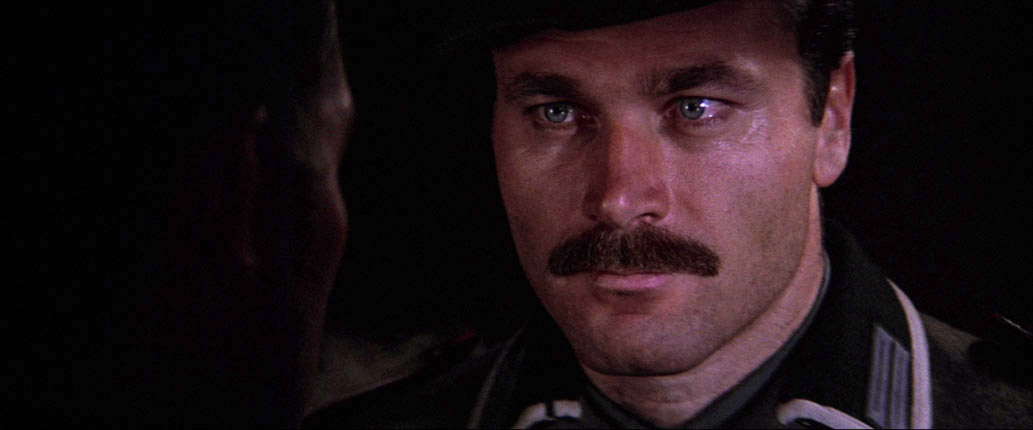
Tour de Force (2020): actor Angus MacInnes recalls his early film role (23’ 50”)
MacInnes entertains with stories about a ridiculously long, scenic taxi ride, the competitiveness of Robert Shaw (a legendary aspect of this actor) and the games you play between set ups. He recounts an interesting story about director Guy Hamilton being ready to shoot Superman abroad and as a tax exile was suddenly off the film when the production moved to Pinewood. He reveals Max von Sydow’s acting technique and the drinking culture alive and significantly hung-over at the time. He confirms how terrible the accommodation was on location adding the detail that the building was condemned and then re-opened and adds his feelings about being dubbed for one version of the film. MacInnes was not a happy camper and with good cause.
From Žabljak with Love (2020): the making of the film as told by construction manager Terry Apsey, stuntman Jim Dowdall, grip Dennis Fraser, chief hairdresser Colin Jamison, and chief make-up artist Peter Robb-King(27’ 42”)
This is a cracker if only for the many stories of what sounds like the worst hotel in Europe. Film crews (especially those in the more unglamorous roles) are fascinating people and see life in very different ways. I’ve worked on a few features in a lowly capacity but the idea of being efficient and fast is quite rightly the primary skill of most people on a crew. This collection from a wide range of film crew roles on Force 10 is never less than entertaining. There is an Alistair McLean taxi story that had me howling. It still staggers me how ingrained (no pun intended) in the culture alcohol was in the not so distant past.
A Life Behind the Lens (2020): a tribute to the acclaimed cinematographer Christopher Challis, featuring interviews with fellow directors of photography and camera crew Dennis Fraser, Oswald Morris, John Palmer and Sydney Samuelson, as well as archival footage of Challis(32’ 16”)
This is a loving tribute to a seemingly wonderful cameraman and man, Chris Challis. A 2009 interview with the great man means we actually get to see and hear from him personally. There’s not a single bad word from a host of his colleagues. No, all those darker comments were saved for director Michael Powell. Challis has some great stories from the production of The Red Shoes. He had a favour once asked of him by Cary Grant to make him look more butch. Hmmm. He also worked with Billy Wilder and all was formal on the set of The Private Life of Sherlock Holmes until Challis invited the famed director to look through the viewfinder and Wilder comically blurted out his supreme lack of technical talent and all the formality dropped away… Nice.
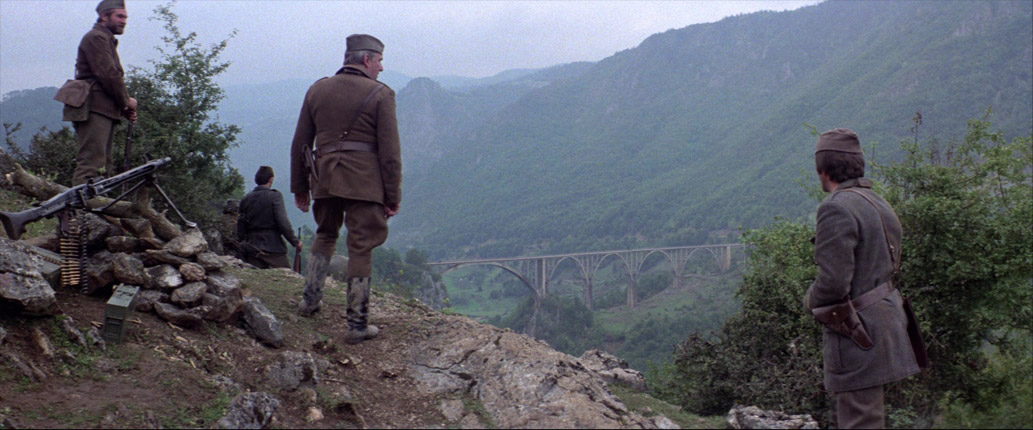
The BEHP Interview with Ron Goodwin (1999): archival video, made as part of the British Entertainment History Project, featuring the celebrated composer in conversation with Linda Wood (88’ 34”)
In the comfort of a favoured armchair, one of the UK’s most respected composers takes us through his life from learning the trumpet to get into the school orchestra, his first documentary film about an oil refinery all the way to his glory days scoring classics like Day of the Triffids, 633 Squadron, Where Eagles Dare (now that’s a master ear-worm) and Hitchcock’s Frenzy. The man, interviewed in 1999 at the age of 74 gives off the air of a man whose life was enjoyed to the full doing what he loved and as such it’s an entertaining watch as well as a great listen. I’m not sure if we learn who the other man is chipping in with details every now and again. Goodwin notes how these days young producers probably wanted to work with young composers, advice Brian de Palma and Martin Scorsese gleefully ignored when a chance came to work with one of their heroes, composer extraordinaire, Bernard Herrmann. He reasons that he got the Frenzy gig because editor John Jympson may have sold him to Hitch after Goodwin and Jympson’s pairing on Where Eagles Dare. As a side note, in 1976 John Jympson was assigned to edit an American film shot in the UK, didn’t get what the director wanted from the footage which forced the director to fire him and pack up his material and send it off to the US. The three editors who worked on this movie won well deserved Oscars for their efforts. This was how Star Wars was born. All in all, Goodwin’s interview is a treasure trove of industry stories well worth a listen.
A Show of Force (2020): a look at the different versions of Force 10 from Navarone (25’ 14”)
Another fascinating extra that very comprehensively details the small differences between the two versions. Unusually, the editing is subtly different and for those youngsters who never got their hands on film, you have to remember that once you’ve cut your original negative, it’s impossible to extend used shots because negative cutting or matching is a destructive act. In order for negative to be stuck fast to film leader (eventually forming a chequerboard A and B roll from which prints are struck with invisible joins) it has to be cemented on the leader so the next few frames of that cut shot are essentially destroyed. Yes, you can make copies of the negative but a recut of a film to this extent means that the second editor had access to the original rushes and probably worked with a print of the film so that he/she knew which shots were compromised. When it comes to audio, it’s a little easier to change things though mixing time is very expensive. It’s perfectly easy to understand why overdubbed lines come in a choice of expletives (“Oh shit!” becomes “Oh, man!”). Airline and TV versions come with a distinct absence of expletives. There’s also the idea that American distributors might have requested cuts and changes. What’s missing in this comprehensive look at the changes are the reasons why they were made at all and was Guy Hamilton creatively responsible for both versions?
Super 8 version: cut-down home cinema presentation (16’ 55”)
Suitably blurry and full of dust and sparkle with night scenes swallowing up detail and a drastically curtailed 4:3 frame, this is a short but entertaining cut down of the main feature. God knows how many generations the Super 8mm version was away from the original but the format has never been big on definition, high or otherwise. But it’s still an entertaining romp given its truncated form.
Original trailers, TV and radio spots
UK Theatrical Trailer (2’ 42”)
This workperson-like effort has a Patrick Allen sound-alike voice over artist which is notable for the fact that the real Patrick Allen narrates the opening recap of the longer cut. I’m afraid he sent himself up so well in the first series of Black Adder that whenever I hear him now, the words “I’m off to the castle to kill the royal family and claim the throne that isn’t mine by right!”
US Theatrical Trailer (1’ 53”)
“The high adventure that blows with excitement!” That line takes on another meaning this late into the 21st century. The US trailer relies heavily on actor recognition with their faces separated and credits given.
US TV Spot (00’ 30”)
A few lines of relevant dialogue from Shaw and Ford is really all we get here.
UK Radio Spot (00’ 21”)
The real Patrick Allen… “Big action adventure, now showing!” Boffo, chaps!
Image gallery: publicity and promotional material
This features 10 black and white publicity shots of the stars, 2 playful Barbara Bach poses plus 2 of the model dam followed by 20 colour scenes from the film, and 2 colour shots of the dam model. In colour we have 9 more shots of the stars and director and Bach again being asked to pose utterly inappropriately. Then we have 2 black and white front-of-house stills and then 11 in colour followed by a press release and 7 poster designs.
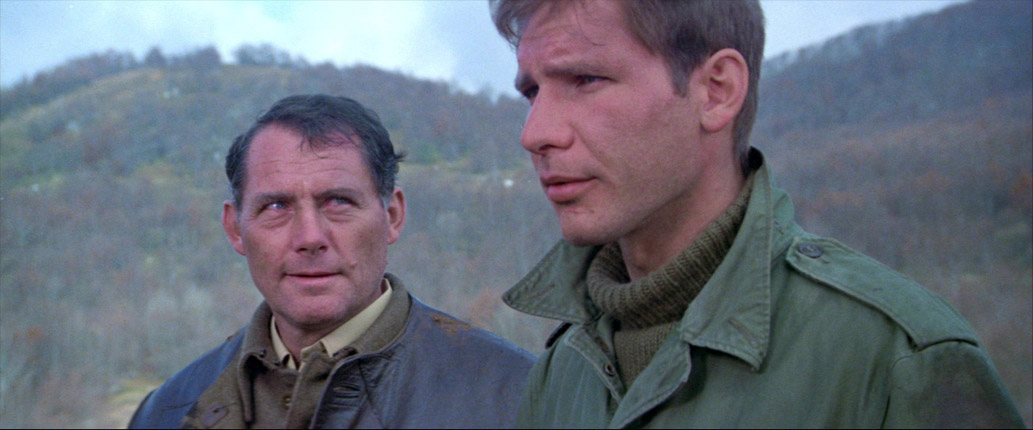
Limited edition exclusive 80-page book with a new essay by Sheldon Hall, archival production reports including interviews with cast and crew members, an interview with actor Robert Shaw, recollections of the film’s Yugoslavia shoot excerpted from the memoirs of cinematographer Christopher Challis and screenwriter George MacDonald Fraser, an overview of contemporary critical responses, and film credits
This is another solid entry in the booklet department. Sheldon Hall’s essay is comprehensive in navigating the twists and turns of the story and the script being written and the legal wrangles inherent in such an enterprise. His research uncovers a few gems and this is a very solid and authoritative article on the making of the film including what must be a slyly ironic conversation between Robert Shaw and producer Sydney Cohn. Also as a 59 year old, it pulled me up short again realising that Robert Shaw died at 51.
Photoplay magazine journalist William Hall braved the Yugoslavian location to talk to the filmmakers. The results are very funny. This was not a welcoming location. Ford comes across as being dryly amusing (we all secretly suspected this, right?). His remark is telling… “The hardest thing we have to do on this film is get up in the morning.” This is a terrific find from the time and has a zinger on every page.
The Robert Shaw interview ‘Robert Shaw Is Acting Up’ from 1978 is a Daily Mail (spits on the ground) interview by Dan Ehrlich where Shaw is more candid than publicists might be comfortable with. It’s heartbreaking to hear of his future ambitions (with an emphasis on avoiding tax and making money to support his large family) and then realising that he actually had no future. Despite its content, this interview comes across with a distinct melancholia hard to shake off. I heartily recommend Shaw’s biography, The Price of Success by John French. The foreword by Jaws co-star Richard Dreyfuss is tremendously moving.
On Location in Montenegro and Jersey features uncredited writer George McDonald Fraser and cinematographer Christopher Challis’s memories of location shooting. Again, these are revealing and amusing in equal measure.
Victoria Radin of The Observer made an extraordinary and prescient (excuse me) observation that “Harrison Ford, the Han Solo of Star Wars who, off screen, looks like a bespectacled very tweed-and-corduroy American assistant professor…” Wo ist Jones?!!
Critical Response holds no special surprises. Force 10 was never going to be treated like a Bergman picture. Reactions dismiss out of hand the efforts of talented men and women working over long periods of time under stressful conditions. I find it somewhat unbecoming that a critic, in the two hour viewing and the short time it takes to author a damning review, can be so desultory. If only the filmmakers had come to them for advice before the shoot. I find that attitude galling. But I do applaud Indicator’s willingness not to cherry pick from or sugar coat the original reviews.
Limited edition exclusive set of five replica production stills
Alas, review copies don’t come with all the bells and whistles so I can’t comment on these but I’m sure they’re all terrific!
If you can get past the era-specific racism that really is an eye-opener in the riot-sparked summer of 2020, you’ll find Force 10 is a solid World War II yarn with relatable heroes and hissable villains. While the film is not going to nestle into ‘classic’ status like the illustrious original, it’s fair to say that it succeeds in what it sets out to do. With Guy Hamilton at the helm, the director of Goldfinger no less, the film is in safe and competent hands. If you’re already a fan, this is a must-have disc. If you fancy a yarn, Force 10’s a solid choice.
* https://filmtalk.org/2015/03/08/guy-hamilton-film-directors-must-be-gentle-to-the-viewers-eye/
|